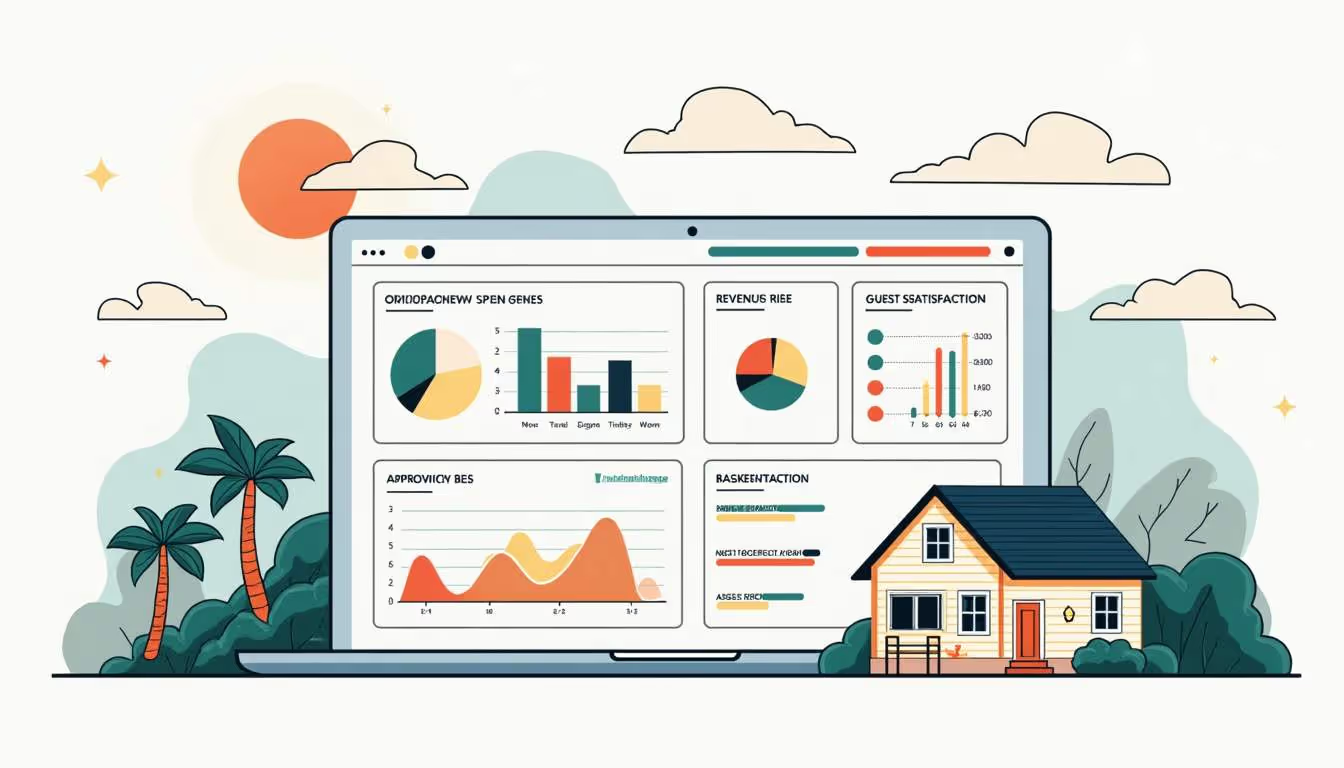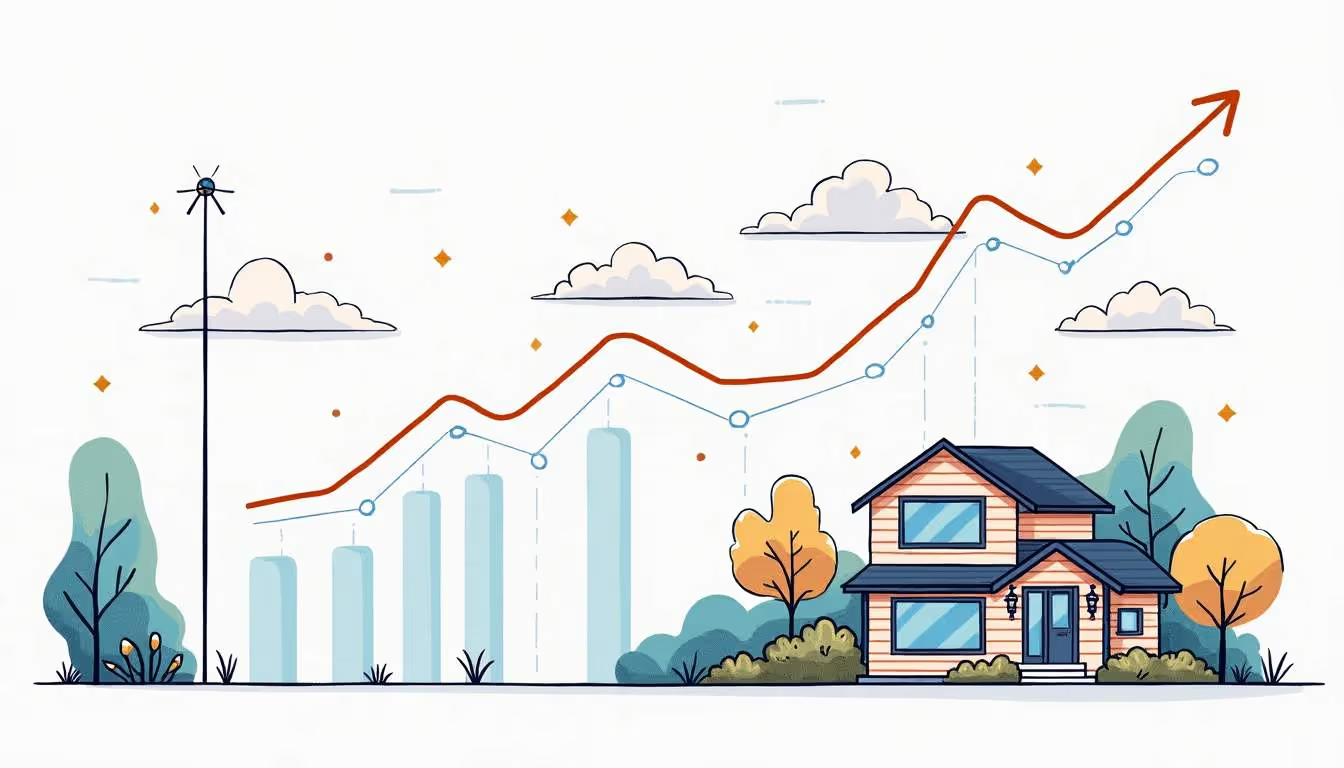How to Generate KPI Dashboards for Vacation Rental Homes
In the bustling arena of vacation rentals, mastering key performance indicators (KPIs) is crucial for thriving. KPI dashboards offer a dynamic visual summary of data, empowering property managers and owners to make strategic choices. This guide delves into crafting impactful KPI dashboards specifically designed for vacation rental properties.
Decoding KPIs in Vacation Rentals
Before embarking on dashboard creation, it's vital to grasp the essence of KPIs and their significance. KPIs are quantifiable metrics that reflect how well a business is meeting its core objectives. In vacation rentals, these metrics illuminate performance, reveal trends, and guide strategic planning. By scrutinizing KPIs, property managers can ensure optimal property performance and make informed tweaks to elevate guest satisfaction and boost revenue.

Essential KPIs for Vacation Rentals
Key KPIs for vacation rental properties include:
Additional KPIs such as guest satisfaction scores, booking lead times, and cancellation rates are also crucial. Monitoring these metrics provides insights into operations and customer preferences. For example, a high cancellation rate might necessitate revisiting booking policies, while low guest satisfaction scores could prompt enhancements in amenities or service protocols. Understanding these metrics enables managers to adapt strategies effectively to market demands.
The Power of Data Visualization
Data visualization is key to making KPIs comprehensible and actionable. A well-crafted dashboard turns complex data into intuitive visuals, enabling quick comprehension of performance trends. This is vital for vacation rentals, where timely decisions can greatly affect profitability. By presenting data in an engaging format, property managers can easily share insights with stakeholders and teams, promoting a collaborative decision-making approach.
Visual tools like graphs, charts, and heat maps can spotlight trends over time, simplifying the identification of patterns and anomalies. For instance, a line graph depicting occupancy rates over the year can reveal seasonal trends, aiding in pricing strategy adjustments. Heat maps can show geographical demand, highlighting areas with higher booking rates, guiding marketing efforts and property enhancements. Visualizing data not only aids immediate decision-making but also supports long-term strategic planning, ensuring vacation rental businesses stay competitive in a dynamic market.
Steps to Develop a KPI Dashboard
Creating a KPI dashboard for vacation rental properties involves several crucial steps to ensure the dashboard is both informative and user-friendly.
1. Determine Key Metrics
The initial step in developing a KPI dashboard is identifying the metrics most relevant to your objectives. Consider which aspects of your rental business you aim to enhance, such as boosting occupancy rates or improving guest experiences.
Engage stakeholders, including property managers and marketing teams, to gather insights on valuable metrics. This collaborative approach ensures the dashboard meets all users' needs. Additionally, incorporate metrics reflecting seasonal trends, like booking patterns during peak times or local events affecting occupancy. A comprehensive view of performance indicators helps anticipate demand changes and adjust strategies accordingly.
2. Select Appropriate Tools
After identifying key metrics, the next step is choosing the right tools for dashboard creation. Various software options exist, from simple spreadsheets to advanced business intelligence platforms.
When selecting a tool, consider factors like ease of use, integration capabilities, and effective data visualization. Popular options include Tableau, Google Data Studio, and Microsoft Power BI, offering templates and features to streamline dashboard creation. Ensure the tool allows real-time data updates for continuous performance monitoring and timely decisions based on the latest information.
3. Design the Dashboard Layout
The dashboard layout is crucial for usability. A well-organized dashboard enables easy navigation and quick information retrieval. Start by grouping related metrics. For instance, financial metrics like ADR and RevPAR can be in one section, while guest satisfaction scores in another.
Incorporate visual elements like graphs and charts for clear data representation. Use color coding to differentiate positive and negative trends, simplifying data interpretation. Consider adding interactive elements for users to filter data by date ranges or property types, enhancing engagement and providing a tailored experience. Prioritizing aesthetics and functionality in dashboard design creates a powerful tool for informed decision-making across your vacation rental business.
Data Sources for Your Dashboard
To generate accurate and meaningful KPI dashboards, gathering data from reliable sources is essential. Data quality directly impacts the insights derived from the dashboard.

Integrating Property Management Systems
Many vacation rental properties use property management systems (PMS) for bookings, guest communications, and financial transactions. Integrating these systems with your KPI dashboard provides real-time data on occupancy rates, revenue, and guest feedback.
Modern PMS platforms often offer APIs for seamless data transfer, ensuring your dashboard reflects the latest information for timely decision-making.
Leveraging Analytics Tools
Besides PMS, analytics tools offer valuable insights into guest behavior and preferences. Platforms like Google Analytics track website traffic, conversion rates, and user demographics, crucial for understanding guest interactions with rental listings and marketing efforts.
Combining data from PMS and analytics tools creates a comprehensive view of vacation rental performance, enabling more informed strategic decisions.
Best Practices for KPI Dashboards
To ensure your KPI dashboard's effectiveness, consider these best practices:
1. Simplify
A cluttered dashboard can overwhelm users and obscure vital information. Aim for simplicity by focusing on relevant metrics and avoiding unnecessary complexity. Use clear labels and concise descriptions for better understanding.
Limit displayed metrics at one time. If additional data is needed, use tabs or filters to allow users to explore specific areas without overwhelming the main view.
2. Update Data Regularly
Data accuracy is crucial for effective decision-making. Ensure your dashboard is regularly updated to reflect current information, whether daily, weekly, or monthly.
Automating data updates saves time and reduces human error risk. Many dashboard tools offer automatic data refresh features, ensuring users always access the latest insights.
3. Solicit User Feedback
Engaging users in dashboard development can lead to a more effective tool. Encourage stakeholder feedback on usability and metric relevance.
Regularly review dashboard performance and adjust based on user input. This iterative approach ensures the dashboard evolves with your vacation rental business's needs.
Analyzing and Acting on the Data
Creating a KPI dashboard is just the beginning; the real value lies in data analysis and action based on insights gained. Effective analysis involves understanding the story behind the numbers.
Spotting Trends and Patterns
Regular dashboard reviews help property managers identify performance trends and patterns. For example, if occupancy rates dip during certain months, managers can explore potential causes like increased competition or changing guest preferences.
Understanding these trends allows proactive adjustments, such as modifying pricing strategies, enhancing marketing efforts, or improving guest services to boost occupancy.
Setting Goals and Benchmarks
Using dashboard insights, property managers can set realistic performance goals and benchmarks. For instance, if the average occupancy rate is 70%, a manager might aim for 80% over the next year.
Clear goals provide a framework for measuring progress. Regularly revisiting these goals and adjusting strategies based on dashboard insights drives continuous improvement in rental performance.
Conclusion
Generating KPI dashboards for vacation rental properties is vital for property managers seeking to enhance performance and profitability. By understanding key metrics, utilizing the right tools, and following best practices, vacation rental owners can create effective dashboards offering valuable insights.

Ultimately, a KPI dashboard's goal is to facilitate informed decision-making. By analyzing data and acting on insights, property managers can optimize operations, enhance guest experiences, and drive revenue growth.
In the fast-paced vacation rental industry, staying ahead requires not just data, but the ability to interpret and act on it effectively. With the right KPI dashboard, property managers can navigate market complexities and achieve long-term success.
Ready to elevate your vacation rental business with a KPI dashboard that integrates seamlessly with your accounting processes? Look no further than VRPlatform. Our comprehensive B2B SaaS solution offers everything from automated owner and manager statements to trust reconciliation and PMS integration, all designed to streamline your operations and enhance financial transparency. Whether you're a property manager, an accounting partner, or a property owner, VRPlatform is tailored to meet your needs. Sign up for a free trial today and experience the difference that automation, compliance, and transparency can make in driving your business forward.



